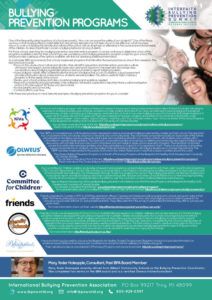
One of the frequently asked questions of school personnel is, “How can we assure the safety of our students?” One of the things we know is that simply putting in metal detectors and arming teachers has not been shown to be effective. What has been shown to work is changing the climate and culture of the school, with an emphasis on attending to the social and emotional needs of the children. An area of particular concern is bullying behavior among students.
For those schools searching for a bullying prevention and intervention program, it can be confusing to determine which of the programs available is best for their school. If you are wondering which bullying prevention program is right for your school, this article provides a glimpse of the options available with links for obtaining additional information.
As a reminder, IBPA recommends that schools implement programs that fall within the best practices as shown from research. The best practices include:
- Focus on the whole school culture and climate—train all staff in prevention and intervention, promote a culture of inclusion and respect, assure adequate supervision and good classroom management, encourage class conversations about bullying, bystander behavior, and how/where to report bullying incidents.
- Assess bullying—adults often underestimate the amount of bullying that occurs. In addition, a good assessment provides information about where and how students are being bullied. This data is useful for tailor-making a program to fit the needs of the school.
- Review your school’s policies and rules concerning bullying and update as needed.
- Respond consistently and appropriately when bullying is witnessed, suspected or reported. Have a solid investigation protocol. Provide support for those who are involved.
- Involve parents and community.
- Continue efforts over time.
With these best practices in mind, here are examples of bullying prevention programs for you to consider:
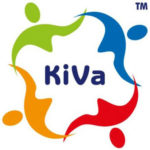
KiVa
KiVa is an anti-bullying program with origins in Finland. It is research-based and is being implemented nationwide in Finland. It includes role-playing exercises to increase empathy and computer simulations to help students think about how they can intervene to reduce bullying. It includes an annual review of data, curriculum and online games, and instruction on tools to use when bullying occurs. KiVa has units that target students 6-9 years old, 10-12 years old, and 13-16 years old. There are materials for teachers, students, and parents. KiVa comes from the Finnish words “Kiusaamista vastaan” which means “against bullying” while the word “kiva” in Finnish means “nice.” KiVa is on the list of Promising Programs at the Blueprints for Healthy Youth Development, University of Colorado, Boulder. You can learn more about that at this link: https://www.blueprintsprograms.org/programs/kiva-antibullying-program/. Read more about KiVa at http://www.kivaprogram.net/

Olweus Bullying Prevention Program (OBPP)
The OBPP is a comprehensive, multi-faceted program designed to reduce and prevent bullying in elementary, middle, and high schools. This approach has components at the schoolwide, classroom, individual, and community levels. The schoolwide component includes an assessment of the nature and prevalence of bullying, assuring adequate adult supervision by training all adults who come in contact with students, and working with a committee to oversee implementation. The classroom component includes an emphasis on defining and enforcing rules against bullying, class discussions with activities that promote a norm of kindness and anti-bullying values, and involvement of parents. The individual component assures that adults intervene appropriately when they see bullying or suspect it or it is reported to them. There is an emphasis on providing support and protection to students who are bullied while also assisting students with bullying tendencies to change their behavior. The OBPP has been implemented in thousands of schools in the United States and in more than a dozen countries around the world.
The Olweus Bullying Prevention Program is on the list of Promising Programs at the Blueprints for Healthy Youth Development, University of Colorado, Boulder. You can learn more about that at this link: https://www.blueprintsprograms.org/programs/olweus-bullying-prevention-program/. Read more about the Olweus Bullying Prevention program at https://olweus.sites.clemson.edu
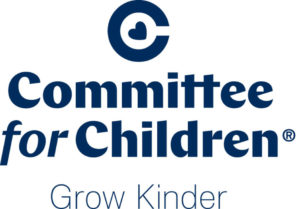
Second Step (Committee for Children)
The Committee for Children, building on decades of research and experience, embed bullying prevention into their wider Social Emotional Learning (SEL) Second Step program. Second Step nurtures a school climate in which there is a visceral sense of safety and respect for each person’s social emotional health and well-being. For Kindergarten through Grade Five students, the Second Step bullying prevention unit teaches students how to recognize, report, and refuse bullying using their social emotional skills. Teachers and other school staff learn how to intervene appropriately. Schools are encouraged to engage families in the effort as well. The curriculum consists of skill and literature-based lessons.
Steps to Respect, the precursor of the updated bullying prevention unit, is listed as one of the Promising Programs at the Blueprints for Healthy Youth Development, University of Colorado, Boulder. You can learn more about that at this link: www.blueprintsprograms.org/programs/steps-to-respect/ For more information about Committee for Children/Second Step can be found here: https://www.cfchildren.org/programs/bullying-prevention/

Friends
Friends originated in Sweden in 1997. In 2014 they opened an office in Colorado and started providing assistance to schools and sports clubs in that state. The Friends philosophy is a systems-wide approach, providing information about how and why bullying occurs in order to prevent it. An annual survey provides data for on-going implementation. They utilize data from the survey to personalize the training they offer to schools and sports clubs. For more information check out their website: https://friendscolorado.org/what-we-do/how-we-work/
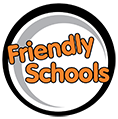
Friendly Schools
Friendly Schools was developed by Dr. Donna Cross in Australia following research on children wellbeing and student learning. It is the first bullying prevention initiative developed through extensive research for Australian children and adolescents. It is a whole school approach promoting a positive social environment, a culture of helping and support, responding quickly and early to reports of bullying. An assessment is done to determine the prevalence and nature of bullying among the students. A “Map the Gap” exercise is completed by the school to identify areas of strength in the school and determine those areas needing additional attention. This information is used to create an action plan for the school. Training is conducted for school staff. Activities for students are designed to be developmentally appropriate for ages 4-14. By promoting positive, sustainable whole-school improvement, schools are able to build their own capacity for change.
For more information: http://friendlyschools.com.au/fsp/
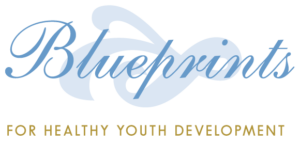
Blueprints for Healthy School Development
A resource that may be useful to schools is the Blueprints for Healthy Student Development. Blueprint’s mission is to provide information on evidence-based initiatives that reduce anti-social behavior and promote the wellbeing of children and youth. Their website provides an annotated list of Promising Programs and can be found here: https://www.blueprintsprograms.org/
Mary Yoder Holsopple, Consultant, Past IBPA Board Member

Mary Yoder Holsopple recently retired from Elkhart Community Schools as the Bullying Prevention Coordinator. She completed two terms on the IBPA board and is a certified Olweus trainer/consultant.

